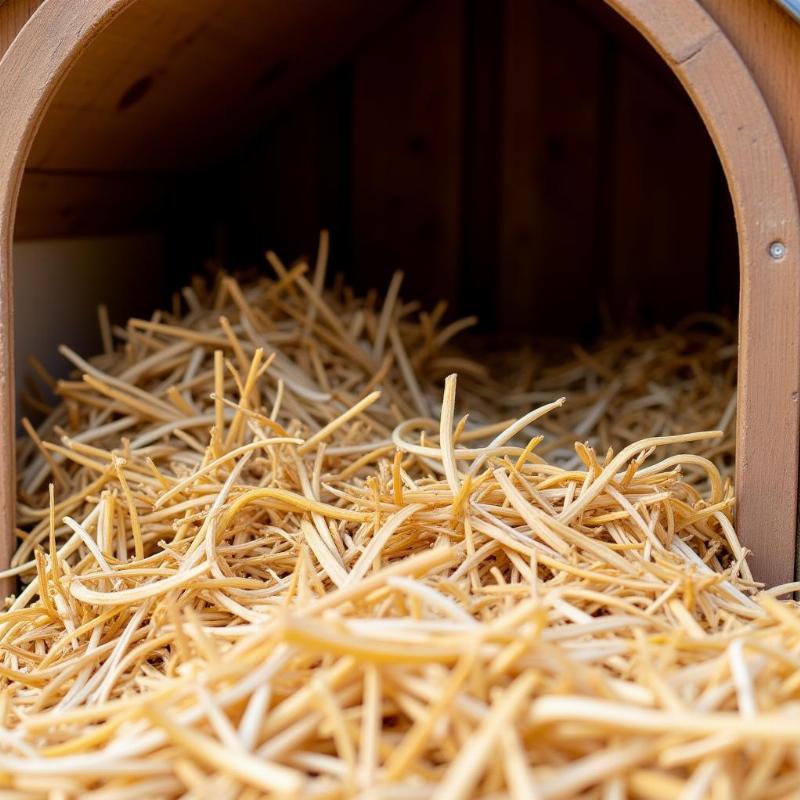Choosing the right bedding for your dog’s house is crucial for their comfort and well-being, especially during harsh weather conditions. While both straw and hay might seem like viable options, understanding their differences and potential benefits and drawbacks is essential to make an informed decision for your furry friend. Straw or hay for a dog house? Let’s explore the pros and cons of each to help you choose the best bedding for your dog.
Understanding the Difference Between Straw and Hay
Before diving into the specifics of each bedding type, it’s important to understand what distinguishes straw from hay. Straw is the dried stalk of grain plants after the grain has been harvested. It’s essentially a byproduct and serves primarily as bedding material for livestock. Hay, on the other hand, is grass cut and dried specifically for animal feed. It’s more nutrient-rich than straw and is often used as forage for horses, cows, and other grazing animals. This fundamental difference influences their suitability as dog house bedding.
Straw for Dog Houses: Pros and Cons
Straw is a readily available and relatively inexpensive option for dog house bedding. Its hollow stalks provide decent insulation against cold temperatures, creating a barrier against the ground’s chill. Straw is also relatively easy to clean and replace, making maintenance straightforward.
However, straw is not without its drawbacks. It can be dusty, which may irritate a dog’s respiratory system, especially for breeds prone to allergies. Straw is also not as absorbent as hay, so it might not be the best choice for dogs who tend to urinate or track moisture into their house. Additionally, straw can harbor insects and pests, requiring regular checks and cleaning.
 Lót ổ chó bằng rơm
Lót ổ chó bằng rơm
Hay for Dog Houses: Pros and Cons
Hay offers better absorbency than straw, making it a potentially better option for dogs who are prone to accidents or live in damp climates. It can also provide a softer and more comfortable nesting environment.
However, hay’s higher nutrient content can attract insects and rodents, posing a risk to your dog’s health and hygiene. Mold growth is another concern with hay, particularly in humid environments, which can trigger allergies and respiratory issues in dogs. Hay is also more expensive than straw and decomposes faster, requiring more frequent replacements.
Which is Best: Straw or Hay for Your Dog’s House?
The best choice between straw and hay for your dog house depends on your individual dog’s needs and your environment. For dogs in dry climates with no allergy concerns, straw can be a cost-effective and adequate bedding solution. However, for dogs in humid climates, or those with allergies or sensitivities, straw might not be the ideal choice.
While hay offers better absorbency and comfort, the risk of mold, insects, and rodents makes it a less suitable option for most dogs. Consider your dog’s specific needs, your local climate, and the potential risks associated with each material before making a decision.
Alternatives to Straw and Hay
If you’re hesitant about using either straw or hay, consider alternatives such as cedar shavings, pine shavings, or recycled paper bedding. These materials are readily available at pet stores and offer various benefits like improved absorbency, insect repellent properties, and reduced dust. Always opt for pet-safe bedding materials to ensure your dog’s health and well-being.
FAQs
-
Is straw safe for puppies? Straw can be safe for puppies if it’s dry and free of mold and pests. However, monitor your puppy closely to ensure they aren’t chewing and ingesting large amounts of straw.
-
How often should I change my dog’s bedding? Change straw bedding every 1-2 weeks, and hay more frequently due to its faster decomposition rate.
-
Can I use blankets in a dog house? Blankets can provide warmth, but they can become damp and harbor bacteria. Opt for easily washable blankets and change them regularly.
-
What about cedar chips for dog house bedding? Cedar chips are a good alternative, offering natural insect-repellent properties. Make sure they are kiln-dried to reduce dust.
-
My dog has allergies, what bedding is best? Hypoallergenic bedding made from recycled paper or other synthetic materials might be the best choice for dogs with allergies.
Expert Insights
“Choosing the right bedding is a crucial part of responsible dog ownership,” says Dr. Emily Carter, DVM, a renowned veterinarian based in New York. “Always prioritize your dog’s comfort and health when selecting bedding materials, considering factors like allergies, climate, and potential health risks.” She further emphasizes the importance of regular cleaning and replacement of bedding to maintain a hygienic environment.
“Remember, providing a comfortable and safe dog house is essential for your furry companion’s overall well-being,” adds Dr. Carter. “Consult with your veterinarian for personalized recommendations based on your dog’s breed, age, and health conditions.”
Connect with Beautdogs.us for Expert Advice
At Beautdogs.us, we’re committed to providing dog owners across America with reliable, comprehensive, and engaging information on dog care and companionship. We offer a wealth of resources on various dog breeds, grooming tips, health advice, and product recommendations. For expert guidance on dog care, connect with us at [email protected] or call us at +1 501-555-7529. Beautdogs.us is your trusted source for all things dog-related, empowering you to provide the best care for your canine companion.